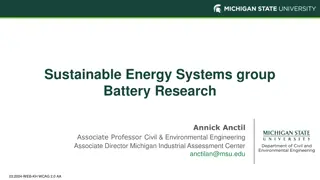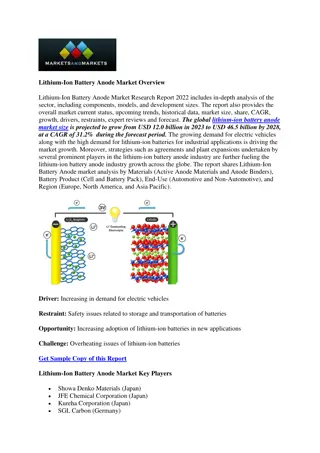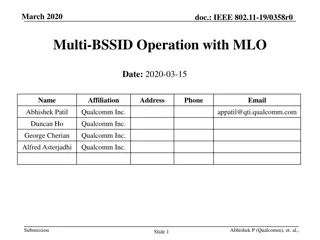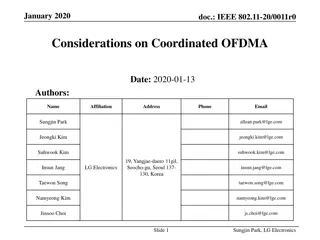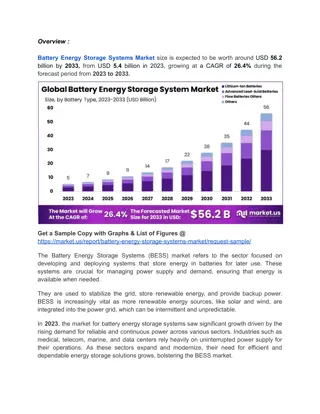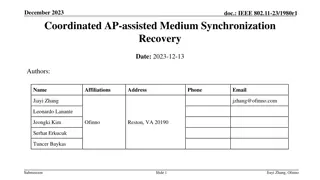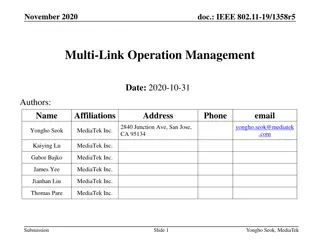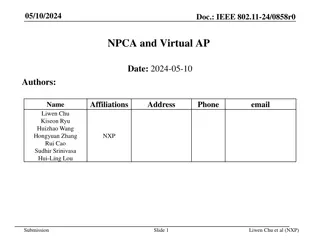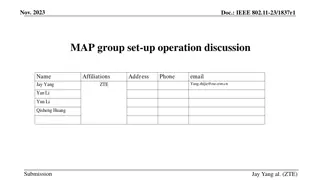Multi-link Operations for Battery Powered APs
This document discusses the challenges and alternative approaches for implementing multi-link operations in battery-powered Access Points (APs) in IEEE 802.11 standards. It covers the design considerations and potential solutions to optimize power usage while maintaining network connectivity.
Download Presentation

Please find below an Image/Link to download the presentation.
The content on the website is provided AS IS for your information and personal use only. It may not be sold, licensed, or shared on other websites without obtaining consent from the author.If you encounter any issues during the download, it is possible that the publisher has removed the file from their server.
You are allowed to download the files provided on this website for personal or commercial use, subject to the condition that they are used lawfully. All files are the property of their respective owners.
The content on the website is provided AS IS for your information and personal use only. It may not be sold, licensed, or shared on other websites without obtaining consent from the author.
E N D
Presentation Transcript
October 2020 Doc.: IEEE 802.11-20/1115r4 Multi-link for Battery Powered AP MLD Date: 2020-10-23 Authors: Name Jay Yang Affiliations Nokia Address Phone email Zhijie.yang@nokia-sbell.com Prabodh Varshney Mika Kasslin Lorenzo Galati Giordano Gang Cheng Yiming Jiang Dingjun He Submission Slide 1 Jay Yang (Nokia)
October 2020 Doc.: IEEE 802.11-20/1115r4 Introduction 802.11be is on its way to define multi-link operations as one way to meet the criteria set in the PAR Multi-link operations may be used both in access point multi-link devices (AP MLD) and in non-AP multi-link devices (non-AP MLD) Each station affiliated with the AP MLD is an AP Each station affiliated with the non-AP MLD is a non-AP STA This implies that whenever the AP MLD has a link in operation, it has the corresponding AP active Active AP is always available on its channel and the current specification doesn t provide any means for it to be periodically unavailable e.g. for power saving purposes In this presentation, we discuss the case of battery powered AP MLDs which would benefit from ability to use the multi-link operations without the burden of always-on APs Submission Slide 2 Jay Yang (Nokia)
October 2020 Current AP MLD design and its challenges in use with battery powered AP MLD Doc.: IEEE 802.11-20/1115r4 An AP MLD has an AP for each link it operates and per the basic rules set for an AP, whenever the AP MLD has a link in operation, it has the corresponding AP active This implies also that MLME-START and MLME-STOP are the mechanisms of an AP MLD to drive its links up and down These restrict use of multi-link operations in battery powered APs which would benefit from means to more dynamically drive its links up and down based on e.g. service needs Non-AP STA AP_1 Non-AP STA AP_2 Non-AP STA AP_3 Non-AP MLD APMLD Submission Slide 3 Jay Yang (Nokia)
October 2020 Doc.: IEEE 802.11-20/1115r4 Alternative approach for battery powered AP MLD Battery powered AP MLD would benefit from a design with more relaxed requirements on STAs that such a device needs to have for its links One possible approach is to allow a battery powered AP MLD to use multi-link operations under control of one AP The AP is responsible for one link Let s call this link primary link One or more other links may be established as well with one or more non-AP STAs Let s call these links secondary links The AP is always on in the primary link while the non- AP STAs associated to the secondary links may benefit from different power saving schemes both on the battery powered AP MLD and on the non- AP MLD side Non-AP STA AP Non-AP STA Non-AP STA Non-AP STA Non-AP STA Non-AP MLD Battery powered APMLD Submission Slide 4 Jay Yang (Nokia)
October 2020 Doc.: IEEE 802.11-20/1115r4 Summary We would like to see multi-link operations of 802.11be to be defined in a way that they can be effectively used in battery powered AP MLDs The current design which requires AP MLD to have an AP for each of its links implies requirements that are heavy for battery powered devices We wonder if there is interest in the TG to consider a design which would give more freedom for link management in battery powered devices Submission Slide 5 Jay Yang (Nokia)
October 2020 Doc.: IEEE 802.11-20/1115r4 SP 1 Do you believe that the current design of multi-link operations which requires each station affiliated to AP MLD to be AP sets too tight requirements for battery powered devices? Yes: No: Abstain: Submission Slide 6 Jay Yang (Nokia)
October 2020 Doc.: IEEE 802.11-20/1115r4 SP 2 Would you be interested in working towards a multi-link solution which would allow battery powered AP MLD to operate two or more links with just one AP affiliated with the device? Yes: No: Abstain: Submission Slide 7 Jay Yang (Nokia)




